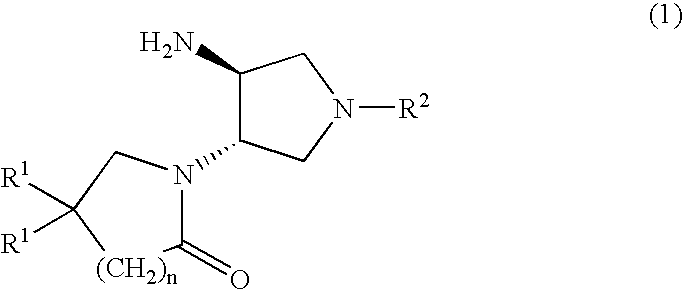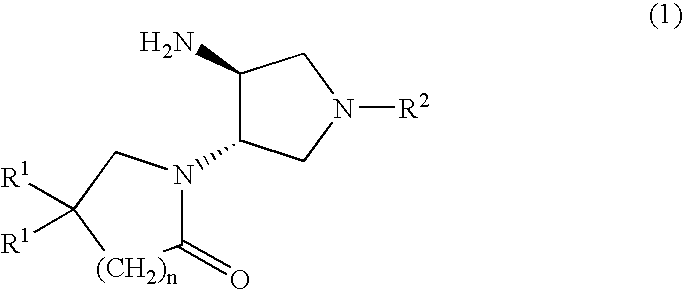Substituted 3-Amino-Pyrrolidino-4-Lactams
a technology of pyrrolidine and derivatives, applied in the field of substituted 3aminopyrrolidine4lactam derivatives, can solve the problems of limiting the use of clinically available hypoglycemic drugs, reducing the effect of clinical trials, and reducing the risk of side effects
- Summary
- Abstract
- Description
- Claims
- Application Information
AI Technical Summary
Benefits of technology
Problems solved by technology
Method used
Image
Examples
preparation 1
tert-butyl (3S,4S)-4-(5,5-difluoro-2-oxopiperidin-1-yl)pyrrolidin-3-ylcarbamate
[0103]
Step 1: (3S,4S)-1-Benzyl-3,4-dihydroxyiyrrolidine-2,5-dione
[0104]Benzylamine (75 g, 0.70 mol) and (−)-tartaric acid (100 g, 700 mol) were heated in boiling xylene (1.0 L) in a Dean-Stark apparatus. After cooling, the product was collected, washed with acetone, and recrystallized from EtOH to afford the product (120 g, 77%). 1H NMR (400 MHz, CDCl3) δ 7.39-7.20 (5H, m), 6.27 (2H, d), 4.58 (1H, d), 4.52 (1H, d), 4.38 (2H, m).
Step 2: (3R,4R)-1-Benzylpyrrolidine-3,4-diol
[0105]To a mechanically stirred and cooled solution (0° C.) of the product from Step 1 (50 g, 0.23 mol) in dry THF (1.24 L) was added sodium aluminum hydride bis-(methoxyethoxide) (289 mL of a 65% Red-A;® / Toluene solution, 0.95 mol) under a nitrogen atmosphere at such a rate that the internal temperature did not exceed 20° C. The reaction mixture was allowed stir at room temperature for 2 h after the addition was complete. The reaction mi...
preparation 2
Methyl (3S,4S)-4-(5,5-difluoro-2-oxopiperidin-1-yl)pyrrolidin-3-ylcarbamate
[0114]
Step 1: (3aS,6aR)-5-Benzyl-2,2-dioxo-tetrahydro-1-oxa-2λ6-thia-3,5-diaza-pentalene-3-carboxylic acid methyl ester
[0115]To a solution of the product from Preparation 1, Step 2 (6.4 g, 33.1 mmol) in 1,4-dioxane (70 mL) was added (methoxycarbonylsulfamoyl)triethylammonium hydroxide, inner salt (19.7 g, 82.8 mol). After stirring at room temperature for 5 min, the solution was warmed to 105° C. and stirred at that temperature for 1.5 h. The solution was cooled to room temperature, concentrated and partitioned between EtOAc (300 mL) and H2O (100 mL). The layers were separated and the organic phase washed with saturated sodium chloride, dried over sodium sulfate and concentrated to give the cyclic sulfamate product as a syrup that solidifies upon standing (10.3 g, 61.9%). 1H NMR (400 MHz, Chloroform-d) δ 7.39-7.23 (m, 5H), 5.19-5.13 (m,1H), 4.68-4.61 (m, 1H), 3.90 (s, 3H), 3.78-3.62 (q, 2H), 3.20-3.10 (m, 2H),...
preparation 3
5-Bromo-4,4-difluoropentanoic acid
[0121]
Step 1
[0122]To a solution of ethyl 4-chloro-4-oxobutyrate (10.0 g, 60.8 mmol) in acetonitrile (100 mL) was added (trimethylsilyl)-diazomethane (39.5 mL of a 2.0 M solution in diethyl ether, 60.8 mmol) over a period of 30 min. After stirring at room temperature for 30 min, the reaction was cooled to −20° C. and 33% hydrogen bromide in acetic acid (14.3 mL, 79.0 mmol) was slowly added over 20 min. The reaction was warmed to room temperature and stirred for 16 h and the solvent was removed without heating. The residue was dissolved in EtOAc (200 mL) and washed with saturated sodium bicarbonate solution and saturated sodium chloride solution. The organic phase was dried over sodium sulfate and concentrated to provide 13.5 g (99%) of the product as an oil. This product contains 33% of the 5-chloro adduct. 1H NMR (400 MHz, Chloroform-d) δ 4.14 (Cl—CH2—, s, 0.6H), 4.12 (q, 2H), 3.95 (Br—CH2—, s, 1.4H), 2.87 (t, 2H), 2.64 (t, 2H), 1.24 (t, 3H).
Step 2:...
PUM
| Property | Measurement | Unit |
|---|---|---|
| temperature | aaaaa | aaaaa |
| temperature | aaaaa | aaaaa |
| temperature | aaaaa | aaaaa |
Abstract
Description
Claims
Application Information
 Login to View More
Login to View More - R&D
- Intellectual Property
- Life Sciences
- Materials
- Tech Scout
- Unparalleled Data Quality
- Higher Quality Content
- 60% Fewer Hallucinations
Browse by: Latest US Patents, China's latest patents, Technical Efficacy Thesaurus, Application Domain, Technology Topic, Popular Technical Reports.
© 2025 PatSnap. All rights reserved.Legal|Privacy policy|Modern Slavery Act Transparency Statement|Sitemap|About US| Contact US: help@patsnap.com



